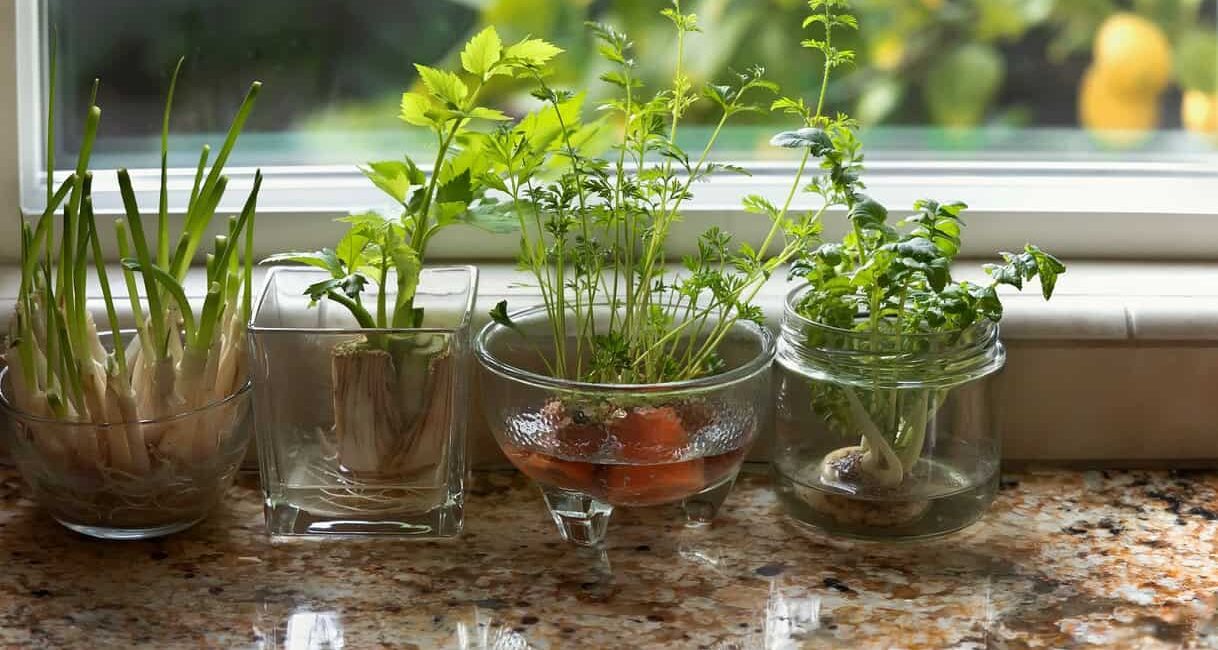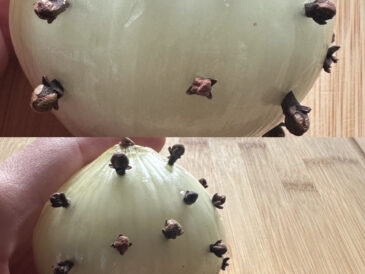- You can eventually transplant the ginger into soil once the roots are well-established.
- Keep the water fresh and make sure the ginger gets enough light but not too much direct sunlight.
6. Potatoes
Regrowing potatoes from kitchen scraps is a great way to grow your own food. While regrowing potatoes in water won’t give you a full new potato immediately, you can grow potato “eyes” in a container to plant in the ground or larger containers to yield full-sized potatoes later on.
How to Regrow:
Save a potato that has started to sprout or cut the potato into pieces, each containing one or more “eyes” (buds). Place the potato pieces in a shallow dish with just enough water to cover the bottom. Change the water every few days, and keep the dish in a sunny spot. Over time, the potato eyes will develop roots, and eventually, shoots will begin to grow.
Tips for Success:
- Once the potato pieces have grown enough roots and shoots, you can plant them in a garden or larger container to continue the growing process.
- If you’re in a colder climate, consider regrowing potatoes indoors in a container until you’re ready to plant them outdoors.
7. Leeks
Leeks are closely related to onions and can be regrown from kitchen scraps just like green onions. While you may not get the full stalks that you originally had, leeks can regrow their green tops, and they are still useful for cooking.
How to Regrow:
Take the root end of a leek and place it in a small jar or glass with enough water to cover the roots. Place the jar in a sunny location and change the water every few days. The leek will begin to grow new shoots, and you can cut the green tops off for use in cooking as needed.
Tips for Success:
- Leeks grow best with sunlight and fresh water. They are quite easy to regrow and take minimal care.
- You can keep regrowing the leek for several rounds before you need to start with a new scrap.
8. Basil (Herb)
Basil is a popular herb used in cooking, especially in Mediterranean and Italian dishes. Regrowing basil from kitchen scraps in water is quick and simple, and you can enjoy fresh basil for your meals year-round.
How to Regrow:
Place a basil cutting in a jar of water, ensuring the cut end of the stem is submerged. Change the water regularly, and place the jar in a sunny spot. Within a couple of weeks, roots will start to form, and you can begin to transplant the basil into soil for continued growth.
Tips for Success:
- Basil does well in a sunny location, and regular water changes will prevent bacteria from forming in the water.
- You can prune the basil regularly to keep it bushy and to encourage more growth.
9. Sweet Potatoes
Regrowing sweet potatoes from kitchen scraps can be a fun and productive way to grow your own food. Like regular potatoes, sweet potatoes can grow new shoots that can be planted to grow full plants.
How to Regrow:
Place a sweet potato in a glass of water, suspending it over the water using toothpicks. The sweet potato will begin to sprout slips (small stems) from the top. Once the slips are a few inches tall, gently twist them off and place them in a jar of water until they grow roots. After that, plant them in the soil.
Tips for Success:
- Sweet potatoes need warm temperatures and plenty of sunlight to thrive, so make sure they’re placed in a location that gets good light.
- After growing slips, you can plant them in large containers or the ground to continue growing.
10. Tomatoes (From Cuttings)
You can also regrow tomatoes from cuttings of an existing plant. While you’ll need to start with a healthy tomato plant, it’s possible to propagate new tomato plants through cuttings, which is a fantastic way to get more out of the tomatoes you already have.
How to Regrow:
Take a healthy tomato stem (about 4-6 inches long) from the plant and place it in a jar of water, making sure that the cut end is submerged. Leave the jar in a sunny location and change the water every few days. Roots will start forming
in about a week or two, at which point you can transplant the rooted cutting into soil.
Tips for Success:
- Tomatoes require a lot of light and warmth to grow properly, so make sure they have enough sun exposure.
- You can regrow several plants from one tomato cutting, making this a great way to propagate your favorite tomato varieties.
Conclusion
Regrowing vegetables from kitchen scraps in water is a simple and rewarding process that can provide you with fresh food year-round. Whether you’re using green onions in your meals, enjoying fresh lettuce in your salads, or snacking on homegrown celery, the process of regrowing from kitchen scraps allows you to become more self-sufficient and reduce waste at the same time.
This method doesn’t require special gardening equipment or large spaces, and it’s something that anyone can do, even if you don’t have a garden. By following the simple steps for each vegetable and using these tips, you’ll soon have a kitchen garden right at your fingertips, all thanks to the scraps you once tossed in the trash. Start regrowing today and enjoy the benefits of fresh, home-grown food, while also contributing to a more sustainable lifestyle.




